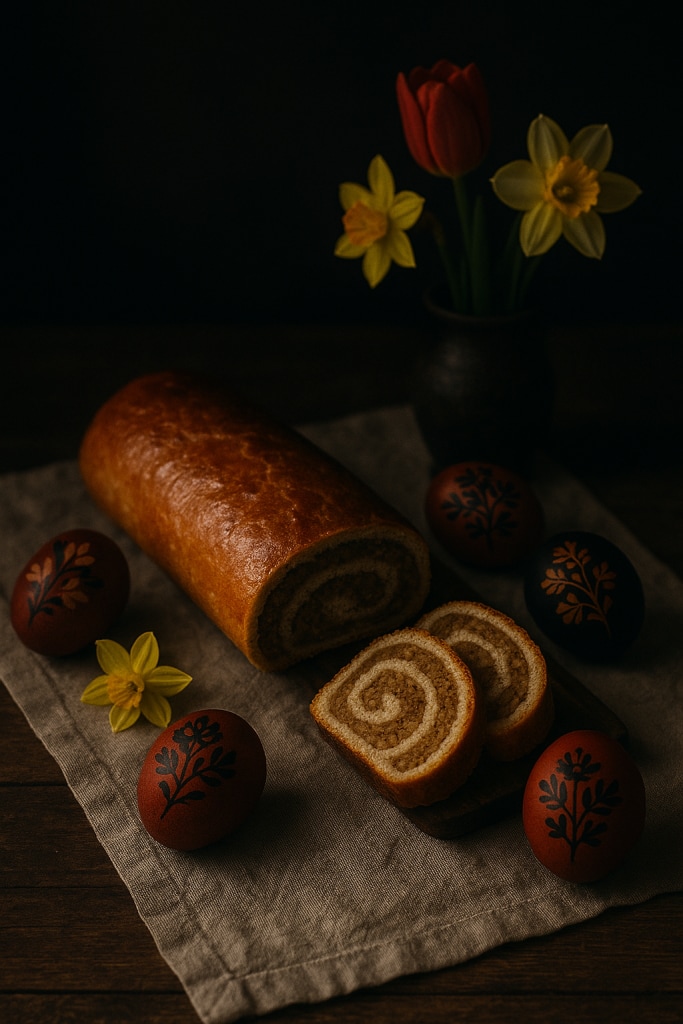The Bejgli is a typical Hungarian dessert for Christmas and Easter.
It is a walnut roll (Diós bejgli) or poppy seed roll (Mákos bejgli).
Of Silesian origin, the dough is made of: flour, yeast, egg yolk, and butter.
After spreading the filling, the dough is rolled into a regular cylinder, brushed with egg yolk, and baked in the oven.
The Mákos bejgli, filled with poppy seeds, also contains raisins, rum, and vanilla.
The Diós bejgli, filled with walnuts, also has raisins and rum, then lemon zest, and obviously the walnuts, chopped.
You can also find the recipe in the book “In cibo veritas, creative and ethnic cuisine” and on the blog another Hungarian walnut-based recipe:

- Difficulty: Medium
- Cost: Economical
- Rest time: 1 Hour
- Preparation time: 10 Minutes
- Portions: 6 People
- Cooking methods: Electric oven, Stove, Oven
- Cuisine: Hungarian
- Seasonality: Easter
Ingredients for the Dios bejgli dough:
- 4 cups all-purpose flour
- 0.25 oz active dry yeast
- 0.35 cup sugar
- 1.4 oz butter
- 3 egg yolks
- to taste salt
- 0.5 cup lukewarm water
- 2 cups chopped walnuts
- 0.5 cup sugar
- 0.5 1/2 tablespoon butter
- 1.75 oz raisins
- to taste rum
- 1 lemon (only grated zest)
- 1 egg yolk (for brushing the surface)
Preparation
For the dough, mix the flour, butter, sugar, and salt, then add the yeast dissolved in lukewarm water to obtain a fairly soft dough.
Add the egg yolks.
Once you have a smooth and homogeneous dough, form 2 equal-sized balls and place them in the fridge covered with plastic wrap for about 1 hour.
For the filling: in a small pot, bring water with sugar to a boil, stirring until you get a syrup.
Add the chopped walnuts, rum-soaked raisins, lemon zest.
Cook over low heat, stirring until you obtain a thick mixture.
Let it cool completely before using it as a filling.Roll out the two doughs using a rolling pin on a floured board.
Place the filling and roll the dough.
Brush with the egg yolk beaten with a tablespoon of water on the surface and place on parchment paper for baking.
Bake at 356°F (180°C) for about 30 minutes.
This is a typical Easter dessert in Hungary.
For the Easter period, I suggest a suitable book: The best 100 Easter recipes at €5.00
What is the difference between diós bejgli and diós rétes?
The Diós Bejgli and the Diós Rétes are two traditional Hungarian desserts based on walnuts, but they differ in dough type, texture, and occasions they are consumed.
🥮 Diós Bejgli – Walnut Roll
Dough: It is a rich leavened dough made with butter and eggs.
Shape: Compact roll, similar to a log.
Preparation: The dough is rolled out, filled with a walnut filling, sugar, milk, and aromas, then rolled up and baked.
Occasions: Traditionally served during Christmas and Easter holidays.
Characteristics: It has a glossy and cracked crust, obtained by brushing the outside with egg before baking.
🍂 Diós Rétes – Walnut Strudel
Dough: Very thin stretched dough, similar to filo dough.
Shape: Long and thin, often rolled into a spiral or folded.
Preparation: The dough is rolled out in thin sheets, filled with ground walnuts, sugar, and aromas, then rolled up and baked.
Occasions: Consumed year-round, often as a daily dessert.
Characteristics: Light and crunchy structure, thanks to multiple thin layers of dough.What is the difference between Diós bejgli and orehova potica?
Diós bejgli (Hungarian) and orehova potica (Slovenian) are two traditional Christmas desserts from Central Europe very similar in form (filled roll), but different in origin, dough, and tradition:
Diós bejgli: Hungary. One of the two classic Christmas bejgli (diós = walnuts, mákos = poppy seeds).
Orehova potica: Slovenia. Slovenian national dessert, also common in Friuli and Istria.
Dough
Bejgli: leavened but compact dough, similar to a shortcrust enriched with butter or lard. The dough is elastic and less sweet.
Potica: soft leavened dough, very similar to that of a brioche or pan brioche. Often more airy and spongy.
Filling
Both have chopped walnuts, sugar, milk, and aromas (often cinnamon, rum, lemon zest).
Potica can also include honey, cream, whipped egg whites, and sometimes raisins.
The proportions in bejgli tend to create a denser and drier filling.
Shape and Baking
Bejgli: rolled, baked as a single loaf, brushed with egg for a glossy and cracked crust.
Potica: often baked in a ring mold (potičnik), but can also be rolled and baked without a mold.
Occasion
Both are eaten at Christmas, but potica is also an Easter and general festive dessert.
Summary:
Diós bejgli → Hungarian roll with a denser dough, walnut filling, and glossy crust.
Orehova potica → Slovenian roll, softer, often baked in a mold, richer, sometimes with cream/honey.

